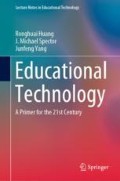Abstract
In software engineering, user-centered design and development are now standard practice with an emphasis on rapid prototyping and getting input from representative users. Taking the typical models of user-centered design in software engineering as a reference and considering the research of user-centered design in educational technology, the following sections will introduce the users’ perspective of educational technology. Emphasis is on user experience, user-centered design, learner-centered design, and the ARCS motivation model.
Access this chapter
Tax calculation will be finalised at checkout
Purchases are for personal use only
References
Clark, R. E., & Estes, F. (1996). Cognitive task analysis, International Journal of Educational. Research, 25(5), 403–417.
Eason, K. (1987). Information technology and organizational change. London: Taylor and Francis.
International Organization for Standardization. (2009). Ergonomics of human system interaction - Part 210: Human-centered design for interactive systems (formerly known as 13407). ISO F±DIS 9241-210:2009.
Karat, J. (1997). Evolving the scope of user-centered design. Communications of ACM, 40(7), 33–38.
Keller, J. M. (1987). Development and use of the ARCS model of motivational design. Journal of Instructional Development, 10(3), 2–10.
Keller, J. M. (1997). Motivational design and multimedia. Beyond the novelty effect. Strategic Human Resource Development Review, 1(1), 188–203.
Keller, J. M. (2009). Motivational design for learning and performance: The ARCS model approach. Springer Science & Business Media.
Landauer, T. K. (1995). The trouble with computers – Usefulness, usability and productivity. Cambridge: The MIT Press.
Meyer, A., Rose, D. H., & Gordon, D. (2014). Universal design for learning: Theory and practice. Wakefield MA: CAST.
Morville, P. (2004). User experience design. Retrieved from http://semanticstudios.com/user_experience_design/.
Norman, D. (1988). The design of everyday things. New York: Doubleday.
Norman, D. A., & Draper, S. W. (1986). User-centered system design: New perspectives on human-computer interaction. Hillsdale, NJ: Lawrence Earlbaum Associates.
Preece, J., Rogers, Y., & Sharp, H. (2002). Interaction design: Beyond human-computer interaction. New York, NY: John Wiley & Sons.
Rose, D. H., & Meyer, A. (2002). Teaching every student in the digital age: Universal design for learning. Alexandria, VA: ASCD.
Soloway, E., Guzdial, M., & Hay, K. E. (1994). Learner-centered design: The challenge For HCI In the 21st century. Interactions, 1(2), 36–48. http://dx.doi.org/10.1145/174809.174813.
Soloway, E., Jackson, S. L., Klein, J., Quintana, C., Reed, J., Spitulnik, J., … & Scala, N. (1996, April). Learning theory in practice: Case studies of learner-centered design. In Proceedings of the SIGCHI conference on Human factors in computing systems (pp. 189–196). ACM. The case is selected from this paper. http://www.sigchi.org/chi96/proceedings/papers/Soloway/es_txt.htm.
Author information
Authors and Affiliations
Corresponding author
Rights and permissions
Copyright information
© 2019 Springer Nature Singapore Pte Ltd.
About this chapter
Cite this chapter
Huang, R., Spector, J.M., Yang, J. (2019). Users Perspective of Educational Technology. In: Educational Technology. Lecture Notes in Educational Technology. Springer, Singapore. https://doi.org/10.1007/978-981-13-6643-7_5
Download citation
DOI: https://doi.org/10.1007/978-981-13-6643-7_5
Published:
Publisher Name: Springer, Singapore
Print ISBN: 978-981-13-6642-0
Online ISBN: 978-981-13-6643-7
eBook Packages: EducationEducation (R0)

